
The Z80 is an 8-bit microprocessor introduced by Zilog as the startup company's first product. The Z80 was conceived by Federico Faggin in late 1974 and developed by him and his 11 employees starting in early 1975. The first working samples were delivered in March 1976, and it was officially introduced on the market in July 1976. With the revenue from the Z80, the company built its own chip factories and grew to over a thousand employees over the following two years.
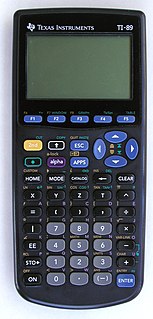
The TI-89 and the TI-89 Titanium are graphing calculators developed by Texas Instruments (TI). They are differentiated from most other TI graphing calculators by their computer algebra system, which allows symbolic manipulation of algebraic expressions—equations can be solved in terms of variables, whereas the TI-83/84 series can only give a numeric result.
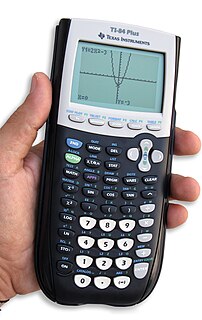
A graphing calculator is a handheld computer that is capable of plotting graphs, solving simultaneous equations, and performing other tasks with variables. Most popular graphing calculators are also programmable and therefore considered to be programmable calculators, allowing the user to create customized programs, typically for scientific, engineering and education applications. Because they have large displays in comparison to standard four-operation handheld calculators, graphing calculators also typically display several lines of text and calculations at the same time.
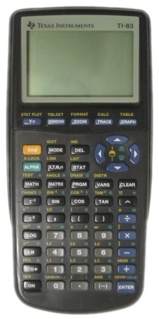
The TI-83 series is a series of graphing calculators manufactured by Texas Instruments.
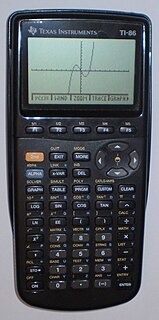
The TI-86 is a programmable graphing calculator introduced in 1996 which was produced by Texas Instruments. The TI-86 uses the Zilog Z80 microprocessor. It is partially backwards-compatible with its predecessor, the TI-85.

The TI-85 is a graphing calculator made by Texas Instruments based on the Zilog Z80 microprocessor. Designed in 1992 as TI's second graphing calculator, it was replaced by the TI-86, which has also been discontinued.

The TI-84 Plus is a graphing calculator made by Texas Instruments which was released in early 2004. There is no original TI-84, only the TI-84 Plus, the TI-84 Plus Silver Edition models, and the TI-84 Plus CE. The TI-84 Plus is an enhanced version of the TI-83 Plus. The key-by-key correspondence is relatively the same, but the 84 features some improved hardware. The archive (ROM) is about 3 times as large, and CPU about 2.5 times as fast. A USB port and built-in clock functionality were also added. The USB port on the TI-84 Plus series is USB On-The-Go compliant, similar to the next generation TI-Nspire calculator, which supports connecting to USB based data collection devices and probes, and supports device to device transfers over USB rather than over the serial link port.
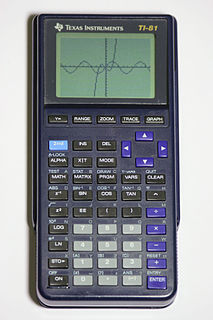
The TI-81 was the first graphing calculator released by Texas Instruments. It was designed in 1990 for use in algebra and precalculus courses. Since its original release, it has been superseded several times by newer calculators: the TI-85, TI-82, TI-83, TI-86, TI-83 Plus, TI-83 Plus Silver Edition, TI-84 Plus, TI-84 Plus Silver Edition, and most recently the TI-Nspire and TI-Nspire CAS. Most of these share the original feature set and 96×64-pixel display that began with this calculator.

The TI-80 is a graphing calculator made by Texas Instruments. It was originally designed in 1995 to be used at a middle school level.
TI-BASIC is the official name of a BASIC-like language built into Texas Instruments (TI)'s graphing calculators. TI-BASIC is a language family of three different and incompatible versions, released on different products:

The TI 73 series is a series of graphing calculators made by Texas Instruments, all of which have identical hardware.
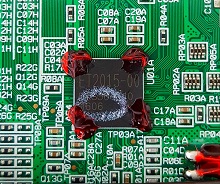
The Zilog eZ80 is an 8-bit microprocessor from Zilog, introduced in 2001. eZ80 is an updated version of the company's first product, the Z80 microprocessor.
The Avigo 10 is a Personal Digital Assistant ("PDA") that was marketed by Texas Instruments from the years 1997 through 2000. It was sold as a lower-priced competitor to the Palm Pilot.

The Compact Computer 40 or CC-40 is a portable computer developed by Texas Instruments and released in March 1983 for US$249. The CC-40 has a single-line 31 character LCD display, weighs 600 grams, and is powered by an AC adapter or can operate for 200 hours on four AA batteries. Memory is not erased by turning the unit off; it can retain data for several months. The CC-40 lacks a way to store data more permanently. Software was only available on cartridge or by typing programs into its built-in BASIC interpreter. The BASIC interpreter is similar but not identical to the TI-99/4A.

The Casio CFX-9850G series is a series of graphing calculators manufactured by Casio Computer Co., Ltd. from 1996 to 2008.

The TI-Nspire is a graphing calculator made by Texas Instruments which was released in July 2007. The original TI-Nspire was developed out of the TI PLT SHH1 prototype calculator, the TI-92 series of calculators released in 1995, and the TI-89 series of calculators released in 1998. The TI-Nspire features a non-QWERTY keyboard and a different key-by-key layout compared to its predecessors. The TI-Nspire allows users to swap out the existing removable keypad with a functional copy of the TI-84 Plus series keypad. The TI-Nspire series I/O has a connector for the TI-Nspire Lab Cradle, another that serves as a connector for TI's wireless network adapter, and a Mini-USB connector for transferring data. The TI-Nspire series is available with and without a computer algebra system.
TilEm is an emulator that simulates certain Texas Instruments calculators on a generic computer. It is similar to TiEmu, uses GTK+, and works on many different operating systems like Linux/Unix, FreeBSD, 32-bit Microsoft Windows and so on.

The Casio Algebra FX series was a line of graphing calculators manufactured by Casio Computer Co., Ltd from 1999 to 2003. They were the successor models to the CFX-9970G, the first Casio calculator with computer algebra system, or CAS, a program for symbolic manipulation of mathematical expressions. The calculators were discontinued and succeeded by the Casio ClassPad 300 in 2003.
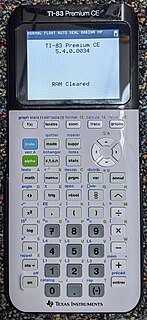
The TI-83 Premium CE is a color graphing calculator, released on January 15, 2015 by TI France. It is the French equivalent of the TI-84 Plus CE, with translated key labels, a French-specific exam mode, and an "exact math" engine.
The NEC μCOM series is a series of microprocessors and microcontrollers manufactured by NEC in the 1970s and 1980s. The initial entries in the series were custom-designed 4 and 16-bit designs, but later models in the series were mostly based on the Intel 8080 and Zilog Z80 8-bit designs, and later, the Intel 8086 16-bit design. Most of the line was replaced in 1984 by the NEC V20, an Intel 8088 clone.















